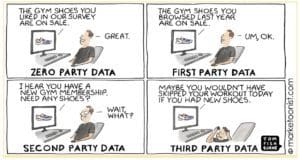Should marketers even consider leads as an indicator? Or just remove the term from their vocabulary altogether?
I think of leads as a – wait for it – leading metric to make sure you’re on the right track with your marketing efforts.
When you have sales cycles in the 3-6-9+ month range, you’ll be flying blind if you only rely on the lagging metric of sales and revenue.
By the time you see that influenced revenue or revenue is down, it’s already too late.
It’s best to set up a few layers of leading indicators – they tell you whether what you’re doing works or not:
– activity metrics like #of content pieces created (posts, webinars, events, podcasts etc)
– website visits or engagement by accounts in your addressable market (or ideal customer profile if you want to be more specific)
– new contacts created
– MQLs, SQLs, sales opportunities
– you probably want to differentiate 2-3 levels of leads.
Then there are lagging metrics, like revenue. I also like pipeline velocity because it’s a smart formula that includes important components.
I’d add that not just revenue from new clients, but perhaps more importantly, recurring revenue (existing clients renewing) is an important business-level lagging indicator. Marketing influences recurring revenue too.
Are people pouring out the baby with the bathwater when they go around posting that leads are bad?
Just because what lazy marketers do with leads (automated email sequences) tends to work less and less, it doesn’t mean doing campaigns and leadgen is bad.
Demand gen and lead gen should go hand in hand. # of leads shouldn’t be an ultimate goal for marketers, but a leading metric.



